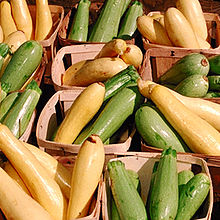Cookbook:Squash
| Squash | |
|---|---|
 | |
| Category | Vegetables |
Cookbook | Recipes | Ingredients | Equipment | Techniques | Cookbook Disambiguation Pages | Ingredients | Vegetables


Squash is a yellow vegetable. (botanically, the fruit of any of four species in the genus Cucurbita) Squash is related to cucumbers and most melons.
There are two general types of squash, summer and winter. Summer squash are eaten unripe, when they have thin edible skins and small soft seeds. Long ago, such squash were only available in summer. They do not keep well. Winter squash are eaten when fully ripe, when the seeds and skin have become hard. Long ago, such squash were valued for their ability to keep during winter. They are generally harvested in fall.
Summer Squash
editSummer squash includes those varieties which are harvested while still immature and when the entire squash is tender and edible. They include the yellow crookneck, the large straightneck, the greenish-white patty pan (petit pan), and the slender green zucchini. The EPA would also include crookneck squash, scallop squash, spaghetti squash, Chinese okra, bitter melon, balsam pear, balsam apple, Chinese cucumber, and chayote. Some of these squash are available at all times of the year.
Look for squash that are tender and well developed, firm, and fresh-appearing. A tender squash has skin is glossy instead of dull, and it is neither hard nor tough. Avoid stale or overmature squash, which will have a dull appearance and a hard, tough surface. Such squash usually have enlarged seeds and dry, stringy flesh. Also avoid squash with discolored or pitted areas.
Among substances present in summer squash are two phytochemicals, coumarins and flavonoids. The skin and rind of summer squash are rich in the nutrient beta-carotene, but the fleshy portion of this vegetable is not. To gain the full nutritional benefits of this vegetable, the skins or rinds must be eaten.
Winter Squash
editWinter squash are those varieties which are marketed only when fully mature. Some of the most important varieties are the small corrugated acorn squash (available all year-round), butternut squash, buttercup squash, green and blue hubbard squash, green and gold delicious squash, and banana squash. Winter squash is most plentiful from early fall until late winter.
Look for full maturity, indicated by a hard, tough rind. Also look for squash that is heavy for its size (meaning a thick wall and more edible flesh). Slight variations in skin color do not affect flavor. Avoid squash with cuts, punctures, sunken spots, or moldy spots on the rind. These are indications of decay. A tender rind indicates immaturity, which is a sign of poor eating quality in winter squash varieties.
To cook a decent-sized winter squash in the traditional way, first slice it in half from stem end to blossom end. If the squash is very large, cut it a few more times. Place the pieces into a baking dish. Cover the dish with foil to keep the squash from getting dry. Cook the squash for a fairly long time, not at a very high temperature, so that it gets soft all the way to the inside. The squash is done when you can easily shove a spoon into it. Serve the squash as it is. Add butter, raisins, and brown sugar at the table.
Types of squash
edit- acorn squash
- butternut squash (butternut pumpkin)
- chayote
- gem squash
- marrow (a UK-specific subset of squash)
- pumpkin
- spaghetti squash
- zucchini (courgette)